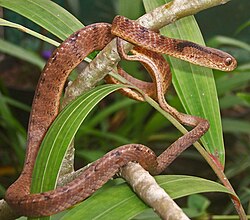zh-TW
在導航的名稱


The Asian snail-eating snakes, which are specialized feeders on terrestrial snails and slugs, have long been recognized as a distinct lineage since the early nineteenth century, first as a subfamily (Pareatinae) within the Colubridae and more recently as a distinct family, Pareatidae. These small snakes are relatively homogeneous in color pattern and scalation and the taxonomy of this group at the species level has been very fluid,Guo et al. (2011) undertook a phylogenetic analysis of the Pareatidae using nuclear and mitochondrial DNA sequence data in an attempt to bring some clarity to this situation. Based on their results, Guo et al. concluded that Pareatidae is composed of four major lineages, including Aplopeltura, Asthenodipsas, and two apparently distinct Pareas lineages. Specifically, they found that P. carinatus and P. nuchalis are genetically quite divergent from their congeners (these two species also differ from other Pareas in cephalic scalation and distribution pattern, as detailed and illustrated in Guo et al. 2011). Geographically, P. carinatus and P. nuchalis occur mainly throughout the Indochinese Peninsula and the Sunda Islands, whereas most Pareas species are found in central and southern China and the northern Indochinese Peninsula (although P. margaritophorus and P. hamptoni are found in the southern Indochinese Peninsula). Guo et al. suggest that (P. carinatus + P. nuchalis) and the remaining Pareas species may belong in different genera. In another finding, although P. formosensis and P. chinensis are morphologically very similar, the DNA-based phylogeny indicates that they are not even sister taxa, contradicting assertions that these two names are synonyms or belong to a "fomosensis-chinensis" species complex.
(Guo et al. 2011 and references therein)
Because dextral (clockwise) coiling predominates among terrestrial snails and this has apparently resulted in most pareatid snakes have evolved asymmetry in mandibular tooth number, which probably facilitates feeding on dextral snails and possibly facilitated the diversification of these snakes. Hoso et al. (2007, 2010) have argued that predation by pareatid snakes has played an important role in the evolution and speciation in some snail lineages (Hoso et al. 2007, 2010 and references therein)
Pareatidae (alamselts maolised, infraselts Alethinophidia) on madude sugukond.
Pareatidae sugukonna süstemaatika pole päris selge: roomajate andmebaas liigitab nad ülemsugukonda Colubroidea[1] ja Vidal et al (2007) paigutavad sugukonna Pareatoidea ülemsugukonda.[2]
Pareatidae (alamselts maolised, infraselts Alethinophidia) on madude sugukond.
Pareatidae suge familia bat da, sailkapen batzuetan Pareatinae gisa aipatzen dena, Colubridaeren barnean. Afrika, Asia eta Amerikan bizi dira.
Pareatidae suge familia bat da, sailkapen batzuetan Pareatinae gisa aipatzen dena, Colubridaeren barnean. Afrika, Asia eta Amerikan bizi dira.
Pareatidae adalah suku ular yang terdiri dari 3 genus ular-ular pemakan siput. Semua jenis ular-ular di dalam kelompok ini merupakan ular-ular yang memangsa bangsa Moluska (terutama siput).[1] Seluruhnya tersebar luas di Asia bagian selatan dan tenggara.
Pareatidae adalah suku ular yang terdiri dari 3 genus ular-ular pemakan siput. Semua jenis ular-ular di dalam kelompok ini merupakan ular-ular yang memangsa bangsa Moluska (terutama siput). Seluruhnya tersebar luas di Asia bagian selatan dan tenggara.
Gliemjēdāju čūsku dzimta jeb gliemjēdājčūsku dzimta (Pareatidae) ir augstāko čūsku dzimta, kas vēl nesenā pagātnē tika klasificēta kā zalkšu dzimtas (Colubridae) apakšdzimta — Pareatinae. Balstoties uz ģenētiskajiem pētījumiem, šī čūsku grupa mūsdienās tiek izdalīta kā dzimta, tādējādi kļūstot par māsas taksonu zalkšu dzimtai, odžu dzimtai un pārējām zalkšu virsdzimtas (Colubroidea) dzimtām.[1] Saskaņā ar Starptautisko rāpuļu datu bāzi (angļu: Reptil Database) šajā dzimtā apvienotas 17 sugas, kas tiek iedalītas 3 ģintīs.[2] Tās ir izplatītas Āzijas austrumos un dienvidos tropu un subtropu biotopos.[1]
Gliemjēdājčūsku galvaskausa morfoloģija ir līdzīga Amerikā dzīvojošām gliemjēdāju čūsku sugām no lielgalvas zalkšu apakšdzimtas (Dipsadinae). Tā ir saīsināta purna daļa un slaidāki, šaurāki zobi.[1] Šīs dzimtas sugas mājo uz sauszemes un kokos, sastopamas mitros mežos, purvos un mangrovju audzēs. Barojas gandrīz vienīgi ar gliemežiem, izņēmums ir strupgalvas gliemjēdājčūska (Aplopeltura boa), kura barojas arī ar ķirzakām.[1][3] Visas gliemjēdājčūsku sugas vairojas ar olām.[1] Āzijas gliemjēdāju čūskas nav indīgas un cilvēkam ir nekaitīgas.
Gliemjēdāju čūsku dzimta jeb gliemjēdājčūsku dzimta (Pareatidae) ir augstāko čūsku dzimta, kas vēl nesenā pagātnē tika klasificēta kā zalkšu dzimtas (Colubridae) apakšdzimta — Pareatinae. Balstoties uz ģenētiskajiem pētījumiem, šī čūsku grupa mūsdienās tiek izdalīta kā dzimta, tādējādi kļūstot par māsas taksonu zalkšu dzimtai, odžu dzimtai un pārējām zalkšu virsdzimtas (Colubroidea) dzimtām. Saskaņā ar Starptautisko rāpuļu datu bāzi (angļu: Reptil Database) šajā dzimtā apvienotas 17 sugas, kas tiek iedalītas 3 ģintīs. Tās ir izplatītas Āzijas austrumos un dienvidos tropu un subtropu biotopos.
Pareatinae ialah sebuah subkeluarga kecil dalam keluarga ular Colubridae yang merangkumi tiga genus.[1] Kebanyakan ahlinya memakan siput babi.
Pareatinae ialah sebuah subkeluarga kecil dalam keluarga ular Colubridae yang merangkumi tiga genus. Kebanyakan ahlinya memakan siput babi.
Họ Rắn hổ mây (danh pháp khoa học: Pareidae[1], trước năm 2015 viết là Pareatidae) là một họ nhỏ, theo truyền thống được coi là phân họ Pareatinae của họ Colubridae[2], nhưng gần đây đã được tách ra thành họ riêng[3][4].
Họ này bao gồm 3 chi với khoảng 20 loài rắn[5]. Nhiều loài trong họ này là rắn chỉ chuyên ăn các loài sên hay ốc sên.
Biểu đồ nhánh trong phạm vi nhóm Caenophidia (Xenophidia) vẽ theo Wiens et al. (2012)[3] và Pyron et al. (2013)[4].
Caenophidia
Acrochordidae (Acrochordoidea)
Xenodermatidae (một phần Colubridae nghĩa cũ)
Pareidae (một phần Colubridae nghĩa cũ)
Homalopsidae (một phần Colubridae nghĩa cũ)
Lamprophiidae (một phần Colubridae nghĩa cũ)
Elapidae (gồm cả Hydrophiidae)
Colubridae nghĩa mới
Biểu đồ phát sinh chủng loài nội bộ họ Pareatidae vẽ theo Pyron et al. (2013)[4].
Pareidae
Họ Rắn hổ mây (danh pháp khoa học: Pareidae, trước năm 2015 viết là Pareatidae) là một họ nhỏ, theo truyền thống được coi là phân họ Pareatinae của họ Colubridae, nhưng gần đây đã được tách ra thành họ riêng.
Họ này bao gồm 3 chi với khoảng 20 loài rắn. Nhiều loài trong họ này là rắn chỉ chuyên ăn các loài sên hay ốc sên.

(本文参照)
セダカヘビ科 (Pareidae) はヘビの科の一つ。3属15種が所属する。アジアに分布し、主に湿潤な森林に生息する。カタツムリを専食することが特徴である。
顎の形態はマイマイヘビ科の一部の種に似るが、これはカタツムリ食に特化したための収斂進化だと考えられる。
分類はReptile Database[2]、和名は『ヘビ大図鑑』による[3]。